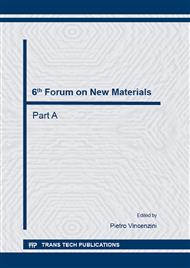[1]
Fujishima A and Honda K 1972 Electrochemical photolysis of water at a semiconductor electrode Nature.
Google Scholar
[2]
Hoffmann M and Martin S 1995 Environmental applications of semiconductor photocatalysis Chem. … 69–96.
Google Scholar
[3]
O'Reagan B and Grätzel M 1991 A low-cost, high-efficiency solar cell based on dye-sensitized colloidal TiO2 films Nature 353.
DOI: 10.1038/353737a0
Google Scholar
[4]
Linsebigler A, Lu G and Jr J Y 1995 Photocatalysis on TiO2 surfaces: principles, mechanisms, and selected results Chem. Rev. 735–58.
DOI: 10.1021/cr00035a013
Google Scholar
[5]
Veréb G, Ambrus Z, Pap Z, Kmetykó Á, Dombi a., Danciu V, Cheesman a. and Mogyorósi K 2012 Comparative study on UV and visible light sensitive bare and doped titanium dioxide photocatalysts for the decomposition of environmental pollutants in water Appl. Catal. A Gen. 417-418 26–36.
DOI: 10.1016/j.apcata.2011.12.018
Google Scholar
[6]
Jin S and Shiraishi F 2004 Photocatalytic activities enhanced for decompositions of organic compounds over metal-photodepositing titanium dioxide Chem. Eng. J. 97 203–11.
DOI: 10.1016/j.cej.2003.04.001
Google Scholar
[7]
Arakawa H and Sayama K 2000 Solar hydrogen production. Significant effect of Na2CO3 addition on water splitting using simple oxide semiconductor photocatalysts Catal. Surv. from Japan 4 75–80.
Google Scholar
[8]
Epling G a and Lin C 2002 Photoassisted bleaching of dyes utilizing TiO2 and visible light. Chemosphere 46 561–70.
DOI: 10.1016/s0045-6535(01)00173-4
Google Scholar
[9]
Choi W, Termin A and Hoffmann M R 1994 The Role of Metal Ion Dopants in Quantum-Sized TiO2: Correlation between Photoreactivity and Charge Carrier Recombination Dynamics J. Phys. Chem. 98 13669–79.
DOI: 10.1021/j100102a038
Google Scholar
[10]
Asahi R, Morikawa T, Ohwaki T, Aoki K and Taga Y 2001 Visible-light photocatalysis in nitrogen-doped titanium oxides. Science 293 269–71.
DOI: 10.1126/science.1061051
Google Scholar
[11]
Quan X, Tan H, Zhao Q and Sang X 2007 Preparation of lanthanum-doped TiO2 photocatalysts by coprecipitation J. Mater. Sci. 42 6287–96.
DOI: 10.1007/s10853-006-1022-7
Google Scholar
[12]
Litter M 1999 Heterogeneous photocatalysis Transition metal ions in photocatalytic systems Appl. Catal. B Environ. 23 89–114.
DOI: 10.1016/s0926-3373(99)00069-7
Google Scholar
[13]
Zhou X, Liu G, Yu J and Fan W 2012 Surface plasmon resonance-mediated photocatalysis by noble metal based composites under visible light J. Mater. Chem. 22 21337.
DOI: 10.1039/c2jm31902k
Google Scholar
[14]
Grzechulska J and Morawski A W 2002 Photocatalytic decomposition of azo-dye acid black 1 in water over modified titanium dioxide Appl. Catal. B Environ. 36 45–51.
DOI: 10.1016/s0926-3373(01)00275-2
Google Scholar
[15]
Amala Infant Joice J, Sivakumar T, Ramakrishnan R, Ramya G, Shanmuga Prasad K P and Arul Selvan D 2012 Visible active metal decorated titania catalysts for the photocatalytic degradation of Amidoblack-10B Chem. Eng. J. 210 385–97.
DOI: 10.1016/j.cej.2012.08.103
Google Scholar
[16]
Wang Q, Chen C, Zhao D, Ma W and Zhao J 2008 Change of adsorption modes of dyes on fluorinated TiO2 and its effect on photocatalytic degradation of dyes under visible irradiation. Langmuir 24 7338–45.
DOI: 10.1021/la800313s
Google Scholar
[17]
You-ji L, Wei C and Sci C 2011 Photocatalytic degradation of Rhodamine B using nanocrystalline TiO2–zeolite surface composite catalysts: effects of photocatalytic condition on degradation efficiency Catal. Sci. Technol. 1 802.
DOI: 10.1039/c1cy00012h
Google Scholar
[18]
Jain P K, Huang X, El-Sayed I H and El-Sayed M a. 2007 Review of Some Interesting Surface Plasmon Resonance-enhanced Properties of Noble Metal Nanoparticles and Their Applications to Biosystems Plasmonics 2 107–18.
DOI: 10.1007/s11468-007-9031-1
Google Scholar
[19]
Zhou X, Hu C, Hu X, Peng T and Qu J 2010 Plasmon-Assisted Degradation of Toxic Pollutants with Ag-AgBr/Al2O3 under Visible-Light Irradiation J. Phys. Chem. C 2746–50.
DOI: 10.1021/jp909697k
Google Scholar
[20]
Kochuveedu S, Kim D and Kim D 2012 Surface-plasmon-induced visible light photocatalytic activity of TiO2 nanospheres decorated by Au nanoparticles with controlled configuration J. Phys. … 2500–6.
DOI: 10.1021/jp209520m
Google Scholar
[21]
Hutter E and Fendler J H 2004 Exploitation of Localized Surface Plasmon Resonance Adv. Mater. 16 1685–706.
DOI: 10.1002/adma.200400271
Google Scholar
[22]
Noguez C 2007 Surface Plasmons on Metal Nanoparticles: The Influence of Shape and Physical Environment J. Phys. Chem. C 111 3806–19.
DOI: 10.1021/jp066539m
Google Scholar
[23]
Lacerda A, Larrosa I and Dunn S 2013 UK patent number GB1318846. 1 London UK Patent Office.
Google Scholar
[24]
Asenjo N G, Santamaría R, Blanco C, Granda M, Álvarez P and Menéndez R 2013 Correct use of the Langmuir–Hinshelwood equation for proving the absence of a synergy effect in the photocatalytic degradation of phenol on a suspended mixture of titania and activated carbon Carbon N. Y. 55 62–9.
DOI: 10.1016/j.carbon.2012.12.010
Google Scholar


